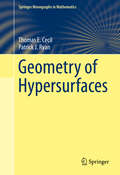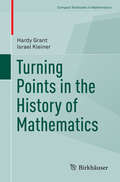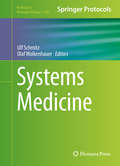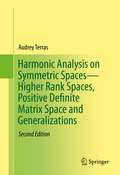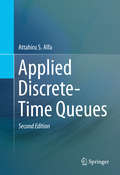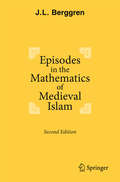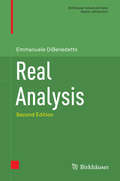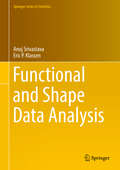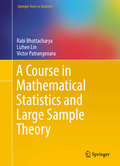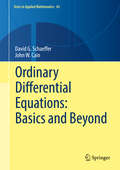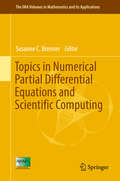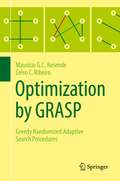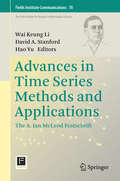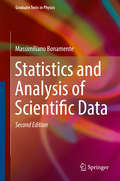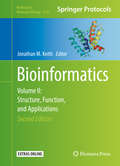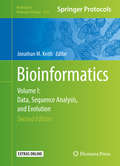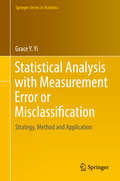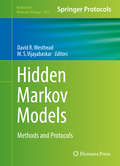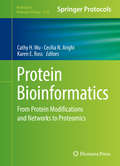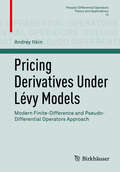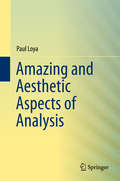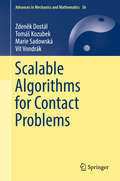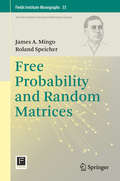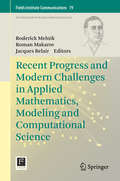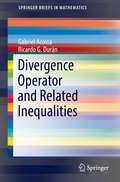- Table View
- List View
Geometry of Hypersurfaces
by Thomas E. Cecil Patrick J. RyanThis exposition provides the state-of-the art on the differential geometry of hypersurfaces in real, complex, and quaternionic space forms. Special emphasis is placed on isoparametric and Dupin hypersurfaces in real space forms as well as Hopf hypersurfaces in complex space forms. The book is accessible to a reader who has completed a one-year graduate course in differential geometry. The text, including open problems and an extensive list of references, is an excellent resource for researchers in this area. Geometry of Hypersurfaces begins with the basic theory of submanifolds in real space forms. Topics include shape operators, principal curvatures and foliations, tubes and parallel hypersurfaces, curvature spheres and focal submanifolds. The focus then turns to the theory of isoparametric hypersurfaces in spheres. Important examples and classification results are given, including the construction of isoparametric hypersurfaces based on representations of Clifford algebras. An in-depth treatment of Dupin hypersurfaces follows with results that are proved in the context of Lie sphere geometry as well as those that are obtained using standard methods of submanifold theory. Next comes a thorough treatment of the theory of real hypersurfaces in complex space forms. A central focus is a complete proof of the classification of Hopf hypersurfaces with constant principal curvatures due to Kimura and Berndt. The book concludes with the basic theory of real hypersurfaces in quaternionic space forms, including statements of the major classification results and directions for further research.
Turning Points in the History of Mathematics
by Hardy Grant Israel KleinerThis book explores some of the major turning points in the history of mathematics, ranging from ancient Greece to the present, demonstrating the drama that has often been a part of its evolution. Studying these breakthroughs, transitions, and revolutions, their stumbling-blocks and their triumphs, can help illuminate the importance of the history of mathematics for its teaching, learning, and appreciation. Some of the turning points considered are the rise of the axiomatic method (most famously in Euclid), and the subsequent major changes in it (for example, by David Hilbert); the "wedding," via analytic geometry, of algebra and geometry; the "taming" of the infinitely small and the infinitely lar≥ the passages from algebra to algebras, from geometry to geometries, and from arithmetic to arithmetics; and the revolutions in the late nineteenth and early twentieth centuries that resulted from Georg Cantor's creation of transfinite set theory. The origin of each turning point is discussed, along with the mathematicians involved and some of the mathematics that resulted. Problems and projects are included in each chapter to extend and increase understanding of the material. Substantial reference lists are also provided. Turning Points in the History of Mathematics will be a valuable resource for teachers of, and students in, courses in mathematics or its history. The book should also be of interest to anyone with a background in mathematics who wishes to learn more about the important moments in its development.
Systems Medicine
by Ulf Schmitz Olaf WolkenhauerThis volume guides readers through the field of systems medicine by defining the terminology, and describing how established computational methods form bioinformatics and systems biology can be taken forward to an integrative systems medicine approach. Chapters provide an outlook on the role that systems medicine may or should play in various medical fields, and describe different facets of the systems medicine approach in action. Ultimately it introduces tools, resources and methodologies from bioinformatics and systems biology, and how to apply these in a systems medicine project. Written for the Methods in Molecular Biology series, chapters include introductions to their respective topics, and discuss experimental and computational approaches, methods, and tools that should be considered for a successful systems medicine project. Systems Medicine aims to motivate and provide guidance for collaborations across disciplines to tackle today's challenges related to human health and well-being.
Harmonic Analysis on Symmetric Spaces—Higher Rank Spaces, Positive Definite Matrix Space and Generalizations
by Audrey TerrasThis text is an introduction to harmonic analysis on symmetric spaces, focusing on advanced topics such as higher rank spaces, positive definite matrix space and generalizations. It is intended for beginning graduate students in mathematics or researchers in physics or engineering. As with the introductory book entitled "Harmonic Analysis on Symmetric Spaces - Euclidean Space, the Sphere, and the Poincaré Upper Half Plane, the style is informal with an emphasis on motivation, concrete examples, history, and applications. The symmetric spaces considered here are quotients X=G/K, where G is a non-compact real Lie group, such as the general linear group GL(n,P) of all n x n non-singular real matrices, and K=O(n), the maximal compact subgroup of orthogonal matrices. Other examples are Siegel's upper half "plane" and the quaternionic upper half "plane". In the case of the general linear group, one can identify X with the space Pn of n x n positive definite symmetric matrices.Many corrections and updates have been incorporated in this new edition. Updates include discussions of random matrix theory and quantum chaos, as well as recent research on modular forms and their corresponding L-functions in higher rank. Many applications have been added, such as the solution of the heat equation on Pn, the central limit theorem of Donald St. P. Richards for Pn, results on densest lattice packing of spheres in Euclidean space, and GL(n)-analogs of the Weyl law for eigenvalues of the Laplacian in plane domains. Topics featured throughout the text include inversion formulas for Fourier transforms, central limit theorems, fundamental domains in X for discrete groups Γ (such as the modular group GL(n,Z) of n x n matrices with integer entries and determinant ±1), connections with the problem of finding densest lattice packings of spheres in Euclidean space, automorphic forms, Hecke operators, L-functions, and the Selberg trace formula and its applications in spectral theory as well as number theory.
Applied Discrete-Time Queues
by Attahiru S. AlfaThis book introduces the theoretical fundamentals for modeling queues in discrete-time, and the basic procedures for developing queuing models in discrete-time. There is a focus on applications in modern telecommunication systems. It presents how most queueing models in discrete-time can be set up as discrete-time Markov chains. Techniques such as matrix-analytic methods (MAM) that can used to analyze the resulting Markov chains are included. This book covers single node systems, tandem system and queueing networks. It shows how queues with time-varying parameters can be analyzed, and illustrates numerical issues associated with computations for the discrete-time queueing systems. Optimal control of queues is also covered. Applied Discrete-Time Queues targets researchers, advanced-level students and analysts in the field of telecommunication networks. It is suitable as a reference book and can also be used as a secondary text book in computer engineering and computer science. Examples and exercises are included.
Episodes in the Mathematics of Medieval Islam
by J. L. BerggrenThis book presents an account of selected topics from key mathematical works of medieval Islam, based on the Arabic texts themselves. Many of these works had a great influence on mathematics in Western Europe. Topics covered in the first edition include arithmetic, algebra, geometry, trigonometry, and numerical approximation; this second edition adds number theory and combinatorics. Additionally, the author has included selections from the western regions of medieval Islam--both North Africa and Spain. The author puts the works into their historical context and includes numerous examples of how mathematics interacted with Islamic society.
Real Analysis
by Emmanuele DibenedettoThe second edition of this classic textbook presents a rigorous and self-contained introduction to real analysis with the goal of providing a solid foundation for future coursework and research in applied mathematics. Written in a clear and concise style, it covers all of the necessary subjects as well as those often absent from standard introductory texts. Each chapter features a "Problems and Complements" section that includes additional material that briefly expands on certain topics within the chapter and numerous exercises for practicing the key concepts. The first eight chapters explore all of the basic topics for training in real analysis, beginning with a review of countable sets before moving on to detailed discussions of measure theory, Lebesgue integration, Banach spaces, functional analysis, and weakly differentiable functions. More topical applications are discussed in the remaining chapters, such as maximal functions, functions of bounded mean oscillation, rearrangements, potential theory, and the theory of Sobolev functions. This second edition has been completely revised and updated and contains a variety of new content and expanded coverage of key topics, such as new exercises on the calculus of distributions, a proof of the Riesz convolution, Steiner symmetrization, and embedding theorems for functions in Sobolev spaces. Ideal for either classroom use or self-study, Real Analysis is an excellent textbook both for students discovering real analysis for the first time and for mathematicians and researchers looking for a useful resource for reference or review.
Functional and Shape Data Analysis
by Anuj Srivastava Eric P. KlassenThis textbook for courses on function data analysis and shape data analysis describes how to define, compare, and mathematically represent shapes, with a focus on statistical modeling and inference. It is aimed at graduate students in analysis in statistics, engineering, applied mathematics, neuroscience, biology, bioinformatics, and other related areas. The interdisciplinary nature of the broad range of ideas covered--from introductory theory to algorithmic implementations and some statistical case studies--is meant to familiarize graduate students with an array of tools that are relevant in developing computational solutions for shape and related analyses. These tools, gleaned from geometry, algebra, statistics, and computational science, are traditionally scattered across different courses, departments, and disciplines; Functional and Shape Data Analysis offers a unified, comprehensive solution by integrating the registration problem into shape analysis, better preparing graduate students for handling future scientific challenges. Recently, a data-driven and application-oriented focus on shape analysis has been trending. This text offers a self-contained treatment of this new generation of methods in shape analysis of curves. Its main focus is shape analysis of functions and curves--in one, two, and higher dimensions--both closed and open. It develops elegant Riemannian frameworks that provide both quantification of shape differences and registration of curves at the same time. Additionally, these methods are used for statistically summarizing given curve data, performing dimension reduction, and modeling observed variability. It is recommended that the reader have a background in calculus, linear algebra, numerical analysis, and computation.
A Course in Mathematical Statistics and Large Sample Theory (Springer Texts in Statistics)
by Rabi Bhattacharya Lizhen Lin Victor PatrangenaruThis graduate-level textbook is primarily aimed at graduate students of statistics, mathematics, science, and engineering who have had an undergraduate course in statistics, an upper division course in analysis, and some acquaintance with measure theoretic probability. It provides a rigorous presentation of the core of mathematical statistics. Part I of this book constitutes a one-semester course on basic parametric mathematical statistics. Part II deals with the large sample theory of statistics - parametric and nonparametric, and its contents may be covered in one semester as well. Part III provides brief accounts of a number of topics of current interest for practitioners and other disciplines whose work involves statistical methods.
Ordinary Differential Equations: Basics and Beyond
by David G. Schaeffer John W. CainThis book develops the theory of ordinary differential equations (ODEs), starting from an introductory level (with no prior experience in ODEs assumed) through to a graduate-level treatment of the qualitative theory, including bifurcation theory (but not chaos). While proofs are rigorous, the exposition is reader-friendly, aiming for the informality of face-to-face interactions. A unique feature of this book is the integration of rigorous theory with numerous applications of scientific interest. Besides providing motivation, this synthesis clarifies the theory and enhances scientific literacy. Other features include: (i) a wealth of exercises at various levels, along with commentary that explains why they matter; (ii) figures with consistent color conventions to identify nullclines, periodic orbits, stable and unstable manifolds; and (iii) a dedicated website with software templates, problem solutions, and other resources supporting the text. Given its many applications, the book may be used comfortably in science and engineering courses as well as in mathematics courses. Its level is accessible to upper-level undergraduates but still appropriate for graduate students. The thoughtful presentation, which anticipates many confusions of beginning students, makes the book suitable for a teaching environment that emphasizes self-directed, active learning (including the so-called inverted classroom).
Topics in Numerical Partial Differential Equations and Scientific Computing
by Susanne C. BrennerNumerical partial differential equations (PDEs) are an important part of numerical simulation, the third component of the modern methodology for science and engineering, besides the traditional theory and experiment. This volume contains papers that originated with the collaborative research of the teams that participated in the IMA Workshop for Women in Applied Mathematics: Numerical Partial Differential Equations and Scientific Computing in August 2014.
Optimization by GRASP: Greedy Randomized Adaptive Search Procedures
by Celso C. Ribeiro Mauricio G.C. ResendeThis is the first book to cover GRASP (Greedy Randomized Adaptive Search Procedures), a metaheuristic that has enjoyed wide success in practice with a broad range of applications to real-world combinatorial optimization problems. The state-of-the-art coverage and carefully crafted pedagogical style lends this book highly accessible as an introductory text not only to GRASP, but also to combinatorial optimization, greedy algorithms, local search, and path-relinking, as well as to heuristics and metaheuristics, in general. The focus is on algorithmic and computational aspects of applied optimization with GRASP with emphasis given to the end-user, providing sufficient information on the broad spectrum of advances in applied optimization with GRASP. For the more advanced reader, chapters on hybridization with path-relinking and parallel and continuous GRASP present these topics in a clear and concise fashion. Additionally, the book offers a very complete annotated bibliography of GRASP and combinatorial optimization. For the practitioner who needs to solve combinatorial optimization problems, the book provides a chapter with four case studies and implementable templates for all algorithms covered in the text. This book, with its excellent overview of GRASP, will appeal to researchers and practitioners of combinatorial optimization who have a need to find optimal or near optimal solutions to hard combinatorial optimization problems.
Advances in Time Series Methods and Applications: The A. Ian McLeod Festschrift (Fields Institute Communications #78)
by Hao Yu Wai Keung Li David A. StanfordThis volume reviews and summarizes some of A. I. McLeod's significant contributions to time series analysis. It also contains original contributions to the field and to related areas by participants of the festschrift held in June 2014 and friends of Dr. McLeod. Covering a diverse range of state-of-the-art topics, this volume well balances applied and theoretical research across fourteen contributions by experts in the field. It will be of interest to researchers and practitioners in time series, econometricians, and graduate students in time series or econometrics, as well as environmental statisticians, data scientists, statisticians interested in graphical models, and researchers in quantitative risk management.
Statistics and Analysis of Scientific Data
by Massimiliano BonamenteThe revised second edition of this textbook provides the reader with a solid foundation in probability theory and statistics as applied to the physical sciences, engineering and related fields. It covers a broad range of numerical and analytical methods that are essential for the correct analysis of scientific data, including probability theory, distribution functions of statistics, fits to two-dimensional data and parameter estimation, Monte Carlo methods and Markov chains. Features new to this edition include: * a discussion of statistical techniques employed in business science, such as multiple regression analysis of multivariate datasets. * a new chapter on the various measures of the mean including logarithmic averages. * new chapters on systematic errors and intrinsic scatter, and on the fitting of data with bivariate errors. * a new case study and additional worked examples. * mathematical derivations and theoretical background material have been appropriately marked, to improve the readability of the text. * end-of-chapter summary boxes, for easy reference. As in the first edition, the main pedagogical method is a theory-then-application approach, where emphasis is placed first on a sound understanding of the underlying theory of a topic, which becomes the basis for an efficient and practical application of the material. The level is appropriate for undergraduates and beginning graduate students, and as a reference for the experienced researcher. Basic calculus is used in some of the derivations, and no previous background in probability and statistics is required. The book includes many numerical tables of data, as well as exercises and examples to aid the readers' understanding of the topic.
Bioinformatics: Volume II: Structure, Function, and Applications (Methods in Molecular Biology #1526)
by Jonathan M. KeithIn Bioinformatics, leading researchers provide a selection of the most useful and widely applicable methods, able to be applied as is, or with minor variations, to many specific problems. Volume II: Structure, Function and Applications contains methods pertinent to the prediction of protein and RNA structures and the analysis and classification of structures, methods for inferring the function of previously identified genomic elements, chiefly protein-coding genes, medical applications in diagnostics and drug discovery, and "meta-methods" for developers of bioinformatics algorithms. Over 80 authors from around the globe have contributed to the two volumes.
Bioinformatics: Volume I: Data, Sequence Analysis, and Evolution (Methods in Molecular Biology #1525)
by Jonathan M. KeithIn Bioinformatics, leading researchers provide a selection of the most useful and widely applicable methods, able to be applied as is, or with minor variations, to many specific problems. Volume II: Structure, Function and Applications contains methods pertinent to the prediction of protein and RNA structures and the analysis and classification of structures, methods for inferring the function of previously identified genomic elements, chiefly protein-coding genes, medical applications in diagnostics and drug discovery, and "meta-methods" for developers of bioinformatics algorithms. Over 80 authors from around the globe have contributed to the two volumes.
Statistical Analysis with Measurement Error or Misclassification
by Grace Y. YiThis monograph on measurement error and misclassification covers a broad range of problems and emphasizes unique features in modeling and analyzing problems arising from medical research and epidemiological studies. Many measurement error and misclassification problems have been addressed in various fields over the years as well as with a wide spectrum of data, including event history data (such as survival data and recurrent event data), correlated data (such as longitudinal data and clustered data), multi-state event data, and data arising from case-control studies. Statistical Analysis with Measurement Error or Misclassification: Strategy, Method and Application brings together assorted methods in a single text and provides an update of recent developments for a variety of settings. Measurement error effects and strategies of handling mismeasurement for different models are closely examined in combination with applications to specific problems. Readers with diverse backgrounds and objectives can utilize this text. Familiarity with inference methods--such as likelihood and estimating function theory--or modeling schemes in varying settings--such as survival analysis and longitudinal data analysis--can result in a full appreciation of the material, but it is not essential since each chapter provides basic inference frameworks and background information on an individual topic to ease the access of the material. The text is presented in a coherent and self-contained manner and highlights the essence of commonly used modeling and inference methods. This text can serve as a reference book for researchers interested in statistical methodology for handling data with measurement error or misclassification; as a textbook for graduate students, especially for those majoring in statistics and biostatistics; or as a book for applied statisticians whose interest focuses on analysis of error-contaminated data. Grace Y. Yi is Professor of Statistics and University Research Chair at the University of Waterloo. She is the 2010 winner of the CRM-SSC Prize, an honor awarded in recognition of a statistical scientist's professional accomplishments in research during the first 15 years after having received a doctorate. She is a Fellow of the American Statistical Association and an Elected Member of the International Statistical Institute.
Hidden Markov Models
by David R. Westhead M. S. VijayabaskarThis volume aims to provide a new perspective on the broader usage of Hidden Markov Models (HMMs) in biology. Hidden Markov Models: Methods and Protocols guides readers through chapters on biological systems; ranging from single biomolecule, cellular level, and to organism level and the use of HMMs in unravelling the complex mechanisms that govern these complex systems. Written in the highly successful Methods in Molecular Biology series format, chapters include introductions to their respective topics, lists of the necessary materials and reagents, step-by-step, readily reproducible laboratory protocols, and tips on troubleshooting and avoiding known pitfalls. Authoritative and practical, Hidden Markov Models: Methods and Protocols aims to demonstrate the impact of HMM in biology and inspire new research.
Protein Bioinformatics: From Protein Modifications and Networks to Proteomics (Methods in Molecular Biology #1558)
by Cathy H. Wu Cecilia N. Arighi Karen E. RossThis volume introduces bioinformatics research methods for proteins, with special focus on protein post-translational modifications (PTMs) and networks. This book is organized into four parts and covers the basic framework and major resources for analysis of protein sequence, structure, and function; approaches and resources for analysis of protein PTMs, protein-protein interactions (PPIs) and protein networks, including tools for PPI prediction and approaches for the construction of PPI and PTM networks; and bioinformatics approaches in proteomics, including computational methods for mass spectrometry-based proteomics and integrative analysis for alternative splice isoforms, for functional discovery. Written in the highly successful Methods in Molecular Biology series format, chapters include introductions to their respective topics, lists of the necessary materials and reagents, step-by-step, readily reproducible laboratory or computational protocols, and tips on troubleshooting and avoiding known pitfalls.Cutting-edge and thorough, Protein Bioinformatics: From Protein Modifications and Networks to Proteomics is a valuable resource for readers who wish to learn about state-of-the-art bioinformatics databases and tools, novel computational methods, and future trends in protein and proteomic data analysis in systems biology. This book is useful to researchers who work in the biotechnology and pharmaceutical industries, and in various academic departments, such as biological and medical sciences and computer sciences and engineering.
Pricing Derivatives Under Lévy Models
by Andrey ItkinThis monograph presents a novel numerical approach to solving partial integro-differential equations arising in asset pricing models with jumps, which greatly exceeds the efficiency of existing approaches. The method, based on pseudo-differential operators and several original contributions to the theory of finite-difference schemes, is new as applied to the L#65533;vy processes in finance, and is herein presented for the first time in a single volume. The results within, developed in a series of research papers, are collected and arranged together with the necessary background material from L#65533;vy processes, the modern theory of finite-difference schemes, the theory of M-matrices and EM-matrices, etc. , thus forming a self-contained work that gives the reader a smooth introduction to the subject. For readers with no knowledge of finance, a short explanation of the main financial terms and notions used in the book is given in the glossary. The latter part of the book demonstrates the efficacy of the method by solving some typical problems encountered in computational finance, including structural default models with jumps, and local stochastic volatility models with stochastic interest rates and jumps. The author also adds extra complexity to the traditional statements of these problems by taking into account jumps in each stochastic component while all jumps are fully correlated, and shows how this setting can be efficiently addressed within the framework of the new method. Written for non-mathematicians, this book will appeal to financial engineers and analysts, econophysicists, and researchers in applied numerical analysis. It can also be used as an advance course on modern finite-difference methods or computational finance.
Amazing and Aesthetic Aspects of Analysis (Undergraduate Texts In Mathematics Ser.)
by Paul LoyaLively prose and imaginative exercises draw the reader into this unique introductory real analysis textbook. Motivating the fundamental ideas and theorems that underpin real analysis with historical remarks and well-chosen quotes, the author shares his enthusiasm for the subject throughout. A student reading this book is invited not only to acquire proficiency in the fundamentals of analysis, but to develop an appreciation for abstraction and the language of its expression. In studying this book, students will encounter:the interconnections between set theory and mathematical statements and proofs;the fundamental axioms of the natural, integer, and real numbers;rigorous ε-N and ε-δ definitions;convergence and properties of an infinite series, product, or continued fraction;series, product, and continued fraction formulæ for the various elementary functions and constants.Instructors will appreciate this engaging perspective, showcasing the beauty of these fundamental results.
Scalable Algorithms for Contact Problems (Advances in Mechanics and Mathematics #36)
by Tomáš Kozubek Zdeněk Dostál Marie Sadowská Vít VondrákThis book presents a comprehensive and self-contained treatment of the authors’ newly developed scalable algorithms for the solutions of multibody contact problems of linear elasticity. The brand new feature of these algorithms is theoretically supported numerical scalability and parallel scalability demonstrated on problems discretized by billions of degrees of freedom. The theory supports solving multibody frictionless contact problems, contact problems with possibly orthotropic Tresca’s friction, and transient contact problems. It covers BEM discretization, jumping coefficients, floating bodies, mortar non-penetration conditions, etc. The exposition is divided into four parts, the first of which reviews appropriate facets of linear algebra, optimization, and analysis. The most important algorithms and optimality results are presented in the third part of the volume. The presentation is complete, including continuous formulation, discretization, decomposition, optimality results, and numerical experiments. The final part includes extensions to contact shape optimization, plasticity, and HPC implementation. Graduate students and researchers in mechanical engineering, computational engineering, and applied mathematics, will find this book of great value and interest.
Free Probability and Random Matrices
by James A. Mingo Roland SpeicherThis volume opens the world of free probability to a wide variety of readers. From its roots in the theory of operator algebras, free probability has intertwined with non-crossing partitions, random matrices, applications in wireless communications, representation theory of large groups, quantum groups, the invariant subspace problem, large deviations, subfactors, and beyond. This book puts a special emphasis on the relation of free probability to random matrices, but also touches upon the operator algebraic, combinatorial, and analytic aspects of the theory. The book serves as a combination textbook/research monograph, with self-contained chapters, exercises scattered throughout the text, and coverage of important ongoing progress of the theory. It will appeal to graduate students and all mathematicians interested in random matrices and free probability from the point of view of operator algebras, combinatorics, analytic functions, or applications in engineering and statistical physics.
Recent Progress and Modern Challenges in Applied Mathematics, Modeling and Computational Science
by Roderick Melnik Roman Makarov Jacques BelairThis volume is an excellent resource for professionals in various areas of applications of mathematics, modeling, and computational science. It focuses on recent progress and modern challenges in these areas. The volume provides a balance between fundamental theoretical and applied developments, emphasizing the interdisciplinary nature of modern trends and detailing state-of-the-art achievements in Applied Mathematics, Modeling, and Computational Science. The chapters have been authored by international experts in their respective fields, making this book ideal for researchers in academia, practitioners, and graduate students. It can also serve as a reference in the diverse selected areas of applied mathematics, modelling, and computational sciences, and is ideal for interdisciplinary collaborations.
Divergence Operator and Related Inequalities
by Gabriel Acosta Ricardo G. DuránThis Brief is mainly devoted to two classical and related results: the existence of a right inverse of the divergence operator and the so-called Korn Inequalities. It is well known that both results are fundamental tools in the analysis of some classic differential equations, particularly in those arising in fluid dynamics and elasticity. Several connections between these two topics and improved Poincar#65533; inequalities are extensively treated. From simple key ideas the book is growing smoothly in complexity. Beginning with the study of these problems on star-shaped domains the arguments are extended first to John domains and then to H#65533;lder α domains where the need of weighted spaces arises naturally. In this fashion, the authors succeed in presenting in an unified and concise way several classic and recent developments in the field. These features certainly makes this Brief useful for students, post-graduate students, and researchers as well.
